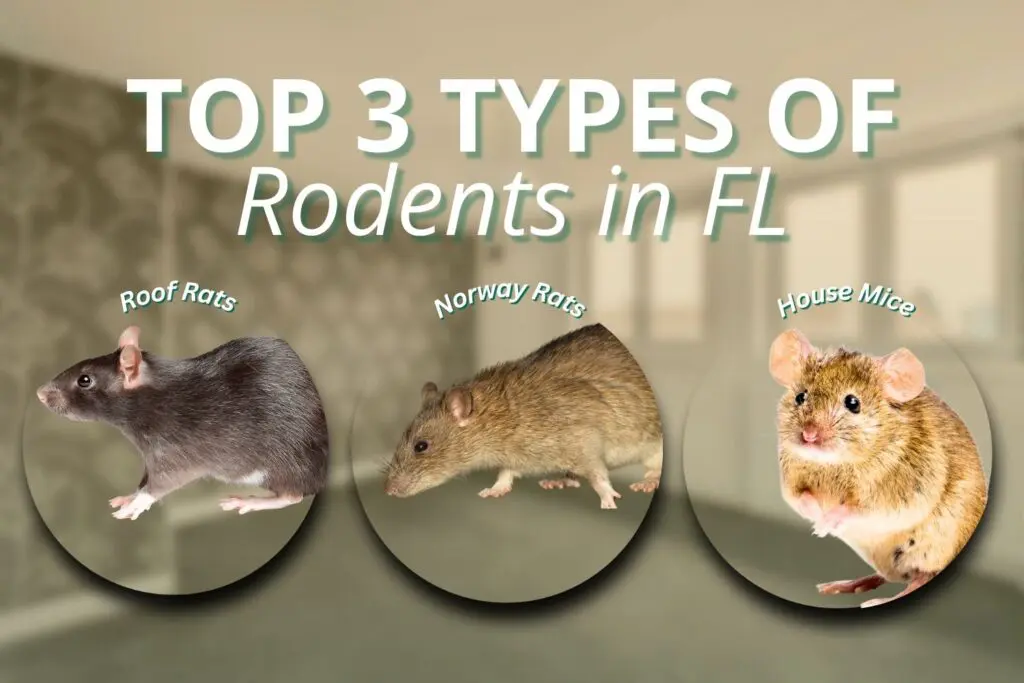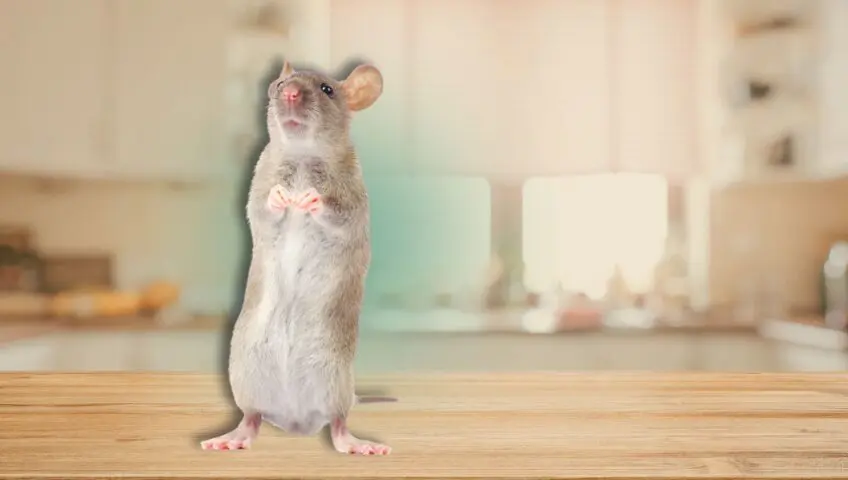This guide explains the most common types of rodents in Florida, where they hide, how they get inside homes, and the signs that show you may have an active infestation.
Rodents are one of the most common pests Florida homeowners deal with, especially in warm coastal regions like the Space Coast. Because of this, many people are surprised at how easily rats and mice can slip into attics, garages, and wall spaces, even when homes look well-sealed from the outside.
Florida’s year-round warmth, heavy vegetation, seasonal rain, and construction patterns all make it easy for rodents to survive and find shelter. Here’s what we think homeowners should know.
Why Are Some Types of Rodents So Common in Florida?
Florida provides the perfect environment for rodents to thrive. The Florida Department of Health reports that rodents breed faster in warm, humid climates. In addition, thick vegetation and long summers allow rat and mouse populations to grow quickly.

1. Warm Weather All Year
Rodents do not slow down much in Florida. For example, with winter temperatures often staying above 50 degrees in many areas, rats and mice can remain active and reproduce through all seasons.
2. Heavy Vegetation and Landscaping
Palms, oak trees, thick shrubs, fruit trees, and tropical landscaping offer endless shelter. The University of Florida IFAS Extension notes that roof rats in particular prefer areas with dense vegetation.
Many neighborhoods along the coast have tree canopies that connect from yard to yard, allowing rodents to climb and travel easily.
3. Homes Built With Attics and Soffit Openings
Florida homes often have multiple attic vents, roof returns, and soffit gaps for airflow. These structures keep homes cooler but also create openings rodents can use when damaged or worn.
4. Storms Push Rodents Toward Homes
Heavy rain and tropical storms can flood rodent nests in the ground or in landscaping. When this happens, rodents move to higher ground, often toward garages, lanais, attics, and sheds.
What Are The Most Common Types of Rodents in Homes?
Three types of rodents are responsible for most indoor activity in Florida: roof rats, Norway rats, and house mice. Understanding the differences helps identify the source of the problem.
Roof Rats
Roof rats are the most common rodent Slug-A-Bug encounters in Florida. They are excellent climbers and prefer warm, elevated spaces.
Recognizing roof rats:
- Slender body
- Large ears
- Tail longer than the body
- Usually dark brown or black
- Found in attics, garages, and rooflines
Roof rats are sometimes called fruit rats because they are attracted to fruit trees, vegetable gardens, and outdoor trash.
Where they hide:
- Attics
- Palm trees
- Roof overhangs
- Gutters
- Dense shrubs
- Lanais and patios
These rats often enter from above, using roof edges or tree branches that touch the home.
Norway Rats
Norway rats are larger and heavier than roof rats. They prefer ground-level areas and often live near foundations, crawlspaces, or drainage areas.
Recognizing Norway rats:
- Thick, heavy body
- Smaller ears
- Tail shorter than the body
- Usually brown or gray
These rats dig burrows and can undermine soil around patios, AC pads, and sheds.
Where they hide:
- Crawlspaces
- Garages
- Foundation gaps
- Drainage lines
- Woodpiles
- Storage areas
Norway rats are less common indoors than roof rats, but can move inside if their outdoor shelter becomes flooded or disturbed.
House Mice
House mice are small but active year-round in Florida. They reproduce quickly and can squeeze into tiny gaps.
Recognizing house mice:
- Small size
- Light gray or brown coat
- Tail about the same length as the body
- Droppings shaped like small pellets
House mice often enter homes through garages or utility openings.
Where they hide:
- Kitchen cabinets
- Laundry rooms
- Pantries
- Behind appliances
- Attics
- Garages
Mice are most common in neighborhoods with older construction or homes with gaps around doors and utilities.
How Do Rodents Get into Florida Homes?
Rodents can squeeze into surprisingly small spaces. The CDC notes that mice can enter gaps as small as a quarter inch, and rats can enter openings as small as a half inch.
In Florida homes, the most common entry points include:
Gaps in Soffits and Rooflines
Soffit damage from storms, age, or wildlife creates ideal openings. Roof rats often chew or widen these gaps to reach the attic.
Tree Branches That Touch the Roof
Roof rats frequently use tree limbs as bridges. Palms, oaks, and fruit trees that touch or hang over the roof give direct access to vents and roof edges.
Damaged or Missing Vent Screens
Attic vent screens can rust, warp, or detach over time. Once a corner loosens, rodents squeeze through.
Gaps Around Electrical and AC Lines
Utility penetrations often leave small openings. These gaps usually expand as materials settle or as rodents chew around them.
Garage Door Gaps
Florida’s humidity can cause weatherstripping to warp or deteriorate. Even a small gap along the bottom of a garage door can allow mice and young rats to enter.
Foundation Cracks
Ground settling and moisture changes can cause small cracks along the slab. Norway rats often use these damaged areas to access the interior.
Lanai and Screen Enclosure Damage
Holes in lanai screens or openings around support posts give rodents an easy way to reach patios and then indoor areas.
Signs of Rodents Inside the Home
Rodents leave clues long before homeowners see one in person. Common signs in Florida households include:
- Droppings near walls, cabinets, or appliances
- Scratching or movement sounds in the attic
- Chewed wires, boxes, or insulation
- Greasy rub marks along baseboards
- Nesting material in corners or insulation
- Sudden insect activity (rodents attract roaches and ants)
- Damage to pantry goods or pet food containers
If these signs appear after a storm or during long warm periods, rodents may have recently moved indoors.
How Are Rodents More Than Just a Nuisance?
Rodents can cause structural and hygiene problems if left unchecked.
Chewing Damage
Rodents chew constantly to control tooth growth. This can damage:
- Electrical wires
- Plumbing lines
- HVAC insulation
- Attic structures
- Stored items
Electrical damage can increase fire risk. The NFPA notes that rodents are suspected in thousands of electrical fires each year.
Contamination
Rodents spread bacteria and contaminants through droppings, urine, and nesting materials. The CDC notes that certain rodent species can transmit pathogens through contact with their waste.
Insulation Damage
Roof rats and mice often burrow into fiberglass insulation, reducing its effectiveness and creating trails that attract other pests.
Odors and Moisture
Rodent nests and waste often lead to strong odors and moisture buildup, especially in closed attic spaces.

How to Keep Rodents Out of Your Home
Prevention in Florida focuses on limiting shelter, blocking access points, and removing attractants.
Trim Back Tree Limbs
Keep trees at least 6 to 8 feet from the roof. Roof rats can jump long distances, and trimming prevents easy travel routes.
Seal Gaps and Openings
Use steel mesh, caulk, and rodent-resistant materials to seal:
- Soffit gaps
- Roofline intersections
- Utility openings
- Foundation cracks
- Attic vent frames
Homeowners often miss gaps near AC lines and cable entry points. These are the top entry points for both mice and roof rats.
Maintain Landscaping
Keep shrubs trimmed away from walls. Rodents hide in landscaping and use branches or leaf piles as cover.
Protect Food Sources
Store pet food, bird seed, and pantry items in sealed containers. Rodents are attracted to easy food sources indoors and outdoors.
Reduce Moisture
Rodents seek water as much as food. Reduce moisture by repairing leaks, cleaning gutters, and ensuring outdoor faucets do not drip.
Inspect the Attic Regularly
Florida attics can become ideal nesting areas because they stay warm year-round. Look for droppings, chewed insulation, or disturbed areas.
How Professionals Remove Rodents Safely
Rodent control requires more than setting traps. Slug-A-Bug uses integrated methods that address the whole property.
Inspection
A trained technician checks the attic, roofline, garage, landscaping, and all possible entry points. The goal is to identify where rodents entered and where they are nesting.
Exclusion
Exclusion involves sealing entry points with materials rodents cannot chew. This may include metal screens, reinforced sealants, and repairs to soffits or vents.
Targeted Trapping
Professionals place traps in areas rodents travel most often. This reduces populations quickly while avoiding areas where pets or children may reach.
Sanitation and Cleanup
Removing droppings, nests, and contaminated insulation is important for restoring the home and preventing odors.
Long-Term Prevention
Slug-A-Bug may recommend trimming vegetation, sealing new gaps, or adding protective barriers to reduce future activity.
Related Questions Florida Homeowners Ask
These support internal linking across Slug-A-Bug’s website.
Why do rodents get into homes during storms?
Flooding pushes rodents to higher ground, often toward attics and garages.
Which rodent is most common in Florida homes?
Roof rats are the most common because they are strong climbers and prefer warm, elevated areas.
Do rodents attract other pests?
Yes. Rodent activity can attract roaches, ants, and other insects.
When to Call a Professional
If you see droppings, hear sounds in the attic, or notice damage to food storage or wiring, a professional inspection is the safest step. Rodent problems often grow quickly in Florida’s warm climate, and the entry points are not always easy to locate.
Slug-A-Bug provides rodent inspections, exclusion, attic services, and long-term prevention for homes across Florida. A trained technician can find the source of the problem, remove the rodents safely, and help protect your home from future activity.
Conclusion
Florida’s climate and landscaping make rodent activity a year-round concern. Understanding which species are most common and how they get inside helps you catch problems early.
Ultimately, with the right prevention steps and a full rodent control plan, you can protect your home and keep rodents from returning.

